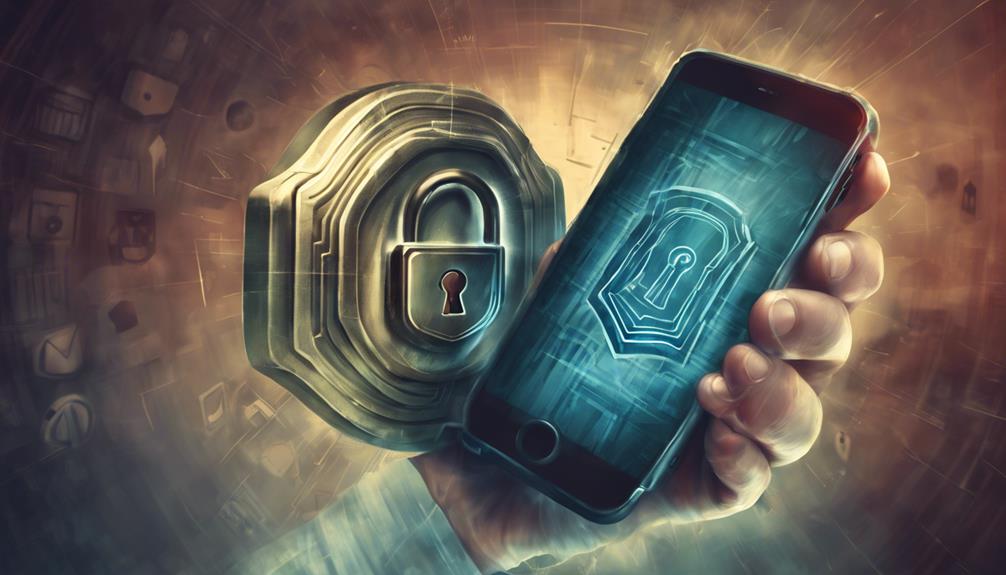Kik Messenger is dedicated to protecting user data from hackers. The platform employs encryption and two-factor authentication, ensuring robust security measures. Encryption maintains data confidentiality and shields against external breaches. Two-factor authentication adds an extra layer of defense to user accounts, exemplifying Kik's commitment to user protection. By prioritizing security, Kik aims to uphold user privacy within the platform. Stay informed about these security features to enhance your online safety on Kik.
Key Takeaways
- Kik implements encryption and two-factor authentication for user data protection.
- Regularly updating the app enhances security against hacking threats.
- Awareness of phishing tactics and avoiding suspicious links is crucial.
- Strong passwords and vigilance mitigate risks of unauthorized access.
- Reporting suspicious activities and enabling privacy settings enhances safety.
Kik Messenger Security Measures
Kik Messenger implements various security measures, including encryption and two-factor authentication, to safeguard user data from potential hacking threats. Encryption plays an important role in protecting user information by encoding it in a way that only authorized parties can access. This guarantees that messages, photos, and other data shared on Kik remain confidential and secure from external breaches.
Additionally, the option for two-factor authentication provides an additional layer of security, requiring users to verify their identity through a secondary method, usually a code sent to their mobile device, before accessing their accounts. These security measures demonstrate Kik's commitment to enhancing user protection and privacy within the platform.
Common Hacker Tactics on Kik

Hackers on Kik employ various tactics to compromise user accounts and data security. One common method is through phishing attempts, where deceptive links are used to extract sensitive information. Another tactic used by hackers is password guessing attacks to gain unauthorized access to accounts. Additionally, hackers distribute malicious links and files that can harm users' devices. These tactics highlight the importance of staying vigilant and cautious while using Kik to safeguard personal information and cybersecurity.
It is crucial for users to be aware of these threats and take proactive measures to protect their accounts and data from potential breaches. By being cautious of suspicious links or messages, using strong and unique passwords, and enabling two-factor authentication, users can significantly reduce the risk of falling victim to hackers on Kik.
Hacker Phishing Attempts
Phishing attempts on the messaging platform Kik involve deceptive tactics aimed at extracting sensitive information from unsuspecting users. Hackers often employ various strategies to lure individuals into divulging personal details or financial data.
Here are five key points to take into account regarding hacker phishing attempts:
- Hackers on Kik frequently use phishing links to steal users' login credentials and financial information.
- Phishing attempts may entail sending fake messages or emails that appear genuine, tricking users into sharing sensitive data.
- It is crucial for users to exercise caution when encountering unsolicited messages requesting personal information or urging them to click on suspicious links.
- Kik users are strongly advised to verify the authenticity of messages and links before disclosing any sensitive information.
- Understanding common hacker tactics like phishing can empower users to safeguard themselves against potential security threats on the Kik platform. By remaining vigilant and informed, individuals can enhance their online safety and protect their privacy.
Password Guessing Attacks
Password guessing attacks on messaging platforms like Kik involve hackers systematically attempting various password combinations to gain unauthorized access to user accounts. By utilizing software to automate the process, hackers can quickly test numerous passwords, particularly targeting accounts with weak or commonly used passwords.
To enhance the security of their Kik accounts, users are strongly advised to use strong, unique passwords. Enabling two-factor authentication adds an extra layer of protection, requiring a second form of verification beyond the password. Regularly changing passwords and remaining vigilant against phishing attempts are essential practices to mitigate the risk of falling victim to password guessing attacks on Kik.
Ultimately, taking proactive measures such as robust password creation and enabling additional security features like two-factor authentication can greatly reduce the likelihood of unauthorized access to Kik accounts through password guessing attacks.
Malicious Links and Files
Cybercriminals frequently exploit unsuspecting users on Kik by disseminating malicious links and files that pose significant risks to user security and privacy.
Here are some key points to keep in mind regarding malicious links and files on Kik:
- Phishing links: Hackers often use deceptive links to trick users into revealing sensitive information like passwords or personal details.
- Malware in files: Malicious files shared on Kik can contain harmful software that compromises users' devices and data.
- Avoid clicking on suspicious links: Users should exercise caution and refrain from clicking on links from unknown or untrusted sources to prevent falling victim to hacker attacks.
- Impersonation tactics: Hackers may impersonate genuine users to build trust before sending harmful links or files to compromise accounts.
- Stay vigilant: Being skeptical of unsolicited messages and links is important in protecting oneself from potential hacker threats on Kik.
Importance of Two-Factor Authentication

Two-factor authentication is an important security measure that adds an extra layer of protection to your Kik account. By requiring a second verification step, such as a code sent to your phone, it greatly reduces the risk of unauthorized access, especially if your password is compromised.
Implementing two-factor authentication in Kik is highly recommended to enhance the overall security of your account and safeguard your personal information from potential hackers.
Two-Factor Authentication Basics
Enhancing account security through an additional layer of verification, two-factor authentication has become a fundamental practice in safeguarding online accounts. Kik users can greatly enhance their account security by enabling two-factor authentication.
Here are some basic facts about two-factor authentication:
- Two-factor authentication adds an extra layer of security by requiring users to provide two forms of identification.
- It helps protect accounts even if hackers obtain login credentials.
- Common methods include SMS codes, authenticator apps, and biometric verification.
- Two-factor authentication significantly reduces the risk of unauthorized access.
Kik users can enhance their account security by enabling two-factor authentication.
Benefits for Security
Implementing two-factor authentication on Kik accounts is crucial for bolstering security measures and thwarting potential hacking threats. By requiring users to provide a second form of verification, such as a code sent to their phone, two-factor authentication greatly enhances the safety of their accounts.
This additional layer of security reduces the risk of unauthorized access by hackers, even if they manage to obtain login credentials through various means. Two-factor authentication is a highly recommended security measure for protecting Kik accounts from hacking attempts, ensuring that users' sensitive information remains safe and secure.
Enabling this feature allows users to substantially improve the overall security of their Kik messaging app, offering peace of mind and confidence in the protection of their personal data. In today's digital landscape where cyber threats are prevalent, incorporating two-factor authentication is a proactive step that users can take to safeguard their accounts and maintain a safe online presence.
Implementing in Kik
Users of the Kik messaging app can greatly enhance the security of their accounts by enabling two-factor authentication. This additional security measure goes beyond just using a password and requires users to provide a second form of verification, such as a code sent to their phone.
By implementing two-factor authentication in Kik, users can markedly reduce the risk of unauthorized access, even if a hacker manages to obtain their password. Here are some key points to keep in mind when setting up two-factor authentication:
- Two-factor authentication adds an extra layer of security to your Kik account.
- It helps prevent unauthorized access by requiring a second form of verification.
- Enabling this feature can significantly boost the safety of your account against potential hacker threats.
- Users should prioritize setting up two-factor authentication to safeguard their accounts effectively.
- Implementing two-factor authentication is a vital step in ensuring the security of your Kik account.
Guidelines for Strong Passwords

Utilizing a diverse combination of characters and avoiding easily guessable information are essential guidelines for creating strong passwords on Kik.
When setting up a password for your Kik app, using parental, Stay Safe measures such as incorporating a mix of upper and lower case letters, numbers, and special characters can greatly enhance the security of your account.
It is vital to steer clear of using personal information like birthdays, names, or common words that could be easily guessed by hackers.
Regularly changing your Kik password is another effective strategy to prevent unauthorized access.
Additionally, enabling two-factor authentication provides an extra layer of security, requiring not only a password but also a secondary verification method to access your account.
For added convenience and security, consider utilizing a password manager to generate and store strong, unique passwords for all your online accounts, including Kik, to safeguard your information effectively.
Risks of Clicking Suspicious Links

Exposing oneself to potential phishing attempts and malware installations, clicking on suspicious links within the Kik platform poses significant risks to user data and account security.
- Hackers often disguise malicious links to trick users into revealing sensitive information.
- Clicking on these links may result in the installation of malware, compromising personal data.
- Users should exercise caution and refrain from interacting with unfamiliar or suspicious links to safeguard against hacking incidents.
- Phishing attempts on Kik aim to deceive users into providing confidential details or unauthorized access.
- Educating users about the dangers associated with clicking on suspicious links is essential in thwarting potential hacking incidents.
It is imperative for Kik users to remain vigilant and avoid engaging with dubious links to mitigate the risk of falling victim to phishing attacks or exposing their devices to harmful malware. By understanding the potential consequences of interacting with suspicious links, users can better protect their data and enhance their overall account security.
Benefits of Regular App Updates

Implementing timely app updates for Kik is vital to fortify its security features and safeguard against potential hacking threats. Regular updates play a significant role in maintaining the integrity of the app by patching any security vulnerabilities that hackers could exploit.
By updating Kik regularly, users guarantee that the latest security enhancements are in place, reducing the risk of falling victim to hacking attempts. Hackers often target outdated apps with known vulnerabilities, making the implementation of regular updates essential for bolstering security measures.
These updates not only include bug fixes but also introduce new security features that help prevent unauthorized access to user data. Staying up to date with app updates is a proactive step users can take to enhance the overall security of their Kik accounts and protect themselves from potential cyber threats.
Enhancing User Security Awareness

Enhanced user security awareness is paramount in safeguarding personal information on the Kik messaging platform. To enhance user security awareness, consider the following:
- Utilizing parental control apps: Parents can monitor their children's activities on Kik to make sure they are not exposed to inappropriate content or potential security risks.
- Educating users on recognizing phishing attempts: Understanding how hackers use phishing links on Kik can help users avoid falling victim to scams.
- Encouraging the use of strong, unique passwords: Using complex passwords can greatly reduce the risk of unauthorized access to accounts on Kik.
- Setting privacy settings: Adjusting privacy settings on Kik can limit the exposure of personal information and improve security.
- Reporting inappropriate content: Users should promptly report any inappropriate content or suspicious activities on Kik to help maintain a safe environment for all users.
Recognizing Signs of Unauthorized Access

Detecting signs of unauthorized access is essential for maintaining the security of your Kik account. To recognize potential breaches, keep an eye out for unusual activities such as messages you didn't send or sudden changes in your account settings. Additionally, regularly review your login history to identify any unfamiliar locations or devices that may have accessed your account. Monitoring your account for unrecognized logins or unexpected password changes can also help in detecting unauthorized access attempts. Be wary of phishing attempts, where malicious individuals try to trick you into revealing your login credentials through deceptive means. It is crucial to stay vigilant and cautious when encountering such requests. By being proactive and observant, you can protect your Kik account from unauthorized access and potential security risks.
| Signs of Unauthorized Access | Description | Example |
|---|---|---|
| Unusual Activity | Look for unexpected actions | Messages sent from your account without your knowledge |
| Login History | Check for unfamiliar logins | Logins from a different country without your consent |
| Phishing Attempts | Beware of deceptive requests | Emails asking for your password claiming to be Kik support |
Proactive Measures Against Kik Hacking

To mitigate the risks associated with potential Kik hacking incidents, proactive measures must be taken to safeguard user security and privacy. When using the Kik messenger app, parents need to be aware of the following steps to enhance safety:
- Regularly update the Kik app to make certain the latest security patches are in place.
- Enable two-factor authentication to add an extra layer of protection to your account.
- Avoid clicking on suspicious links or sharing personal information with unknown users.
- Educate children about the risks of interacting with strangers and sharing sensitive information.
- Consider using professional security tools like ClevGuard to monitor and protect against potential Kik hacking threats.
Frequently Asked Questions
Can People Steal Your Info on Kik?
People can steal your info on Kik through phishing links, leading to stolen credentials. Scammers may exploit users with intimate photos for blackmail. Lack of phone number verification raises privacy concerns, and Kik's database could compromise user privacy.
Is Kik Completely Private?
Kik's privacy features offer users a level of anonymity, but it's not completely private. Concerns persist due to potential data tracing, phishing threats, and scams. Users should exercise caution and employ additional security measures.
Does Kik Keep Your IP Address?
Just as a vigilant guardian shields a precious gem, Kik does not retain users' IP addresses during standard interactions. However, caution is advised against using unofficial modded versions to prevent potential exposure of IP addresses.
Can Kik Messages Be Traced?
Kik messages can be traced by the platform through their databases if required. This ability aids in investigations and monitoring for security purposes. It is important for users to be aware of this feature for privacy considerations.
Conclusion
To sum up, ensuring the safety of your Kik Messenger account from hackers requires vigilance and proactive measures. By implementing strong passwords, enabling two-factor authentication, and staying updated on security features, users can greatly reduce the risk of unauthorized access.
Remember, as the saying goes, 'an ounce of prevention is worth a pound of cure.' Stay informed, stay cautious, and prioritize your online security to protect your personal information.









